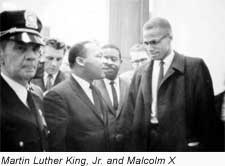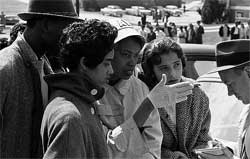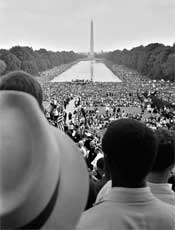The Montgomery Bus Boycott was a political and social protest campaign started in 1955 in Montgomery, Alabama, intended to oppose the city's policy of racial segregation on its public transit system. The ensuing struggle lasted from December 5, 1955, to December 20, 1956, and led to a United States Supreme Court decision that declared the Alabama and Montgomery laws requiring segregated buses unconstitutional.

 Rosa Parks was a black seamstress by profession and secretary for the Montgomery chapter of the NAACP. Shortly before her arrest on Thursday, December 1st, 1955, she had completed a course in "Race Relations" at the Highlander Folk School in Tennessee. The boycott was triggered by her arrest on Thursday, December 1, 1955 when she was charged for violating racial segregation laws in Montgomery, Alabama, after refusing to give her seat on a bus to a white man. The full story says that she was sitting in the fifth row (the first row that blacks could occupy), along with three other blacks. Soon, all of the first four rows were filled up, and a white man walked on. Since blacks and whites couldn't be in the same row, the man wanted all of the blacks to move. The other three blacks complied, but Parks refused. Rosa Parks was a black seamstress by profession and secretary for the Montgomery chapter of the NAACP. Shortly before her arrest on Thursday, December 1st, 1955, she had completed a course in "Race Relations" at the Highlander Folk School in Tennessee. The boycott was triggered by her arrest on Thursday, December 1, 1955 when she was charged for violating racial segregation laws in Montgomery, Alabama, after refusing to give her seat on a bus to a white man. The full story says that she was sitting in the fifth row (the first row that blacks could occupy), along with three other blacks. Soon, all of the first four rows were filled up, and a white man walked on. Since blacks and whites couldn't be in the same row, the man wanted all of the blacks to move. The other three blacks complied, but Parks refused.

 At a church meeting after her arrest led by the new MIA head, Rev. Martin Luther King, a citywide boycott of public transit was proposed to demand a fixed dividing line for the segregated sections of the buses. Such a line would have meant that if the white section of the bus was oversubscribed, whites would have to stand; blacks would not be forced to remit their seats to whites. This demand was to be supplemented by a requirement that all bus passengers receive courteous treatment by bus operators, be seated on a first-come, first-served basis, and blacks be employed as bus drivers. The proposal was passed, and the boycott was to commence the following Monday. To publicize the impending boycott it was advertised at black churches throughout Montgomery the following Sunday. At a church meeting after her arrest led by the new MIA head, Rev. Martin Luther King, a citywide boycott of public transit was proposed to demand a fixed dividing line for the segregated sections of the buses. Such a line would have meant that if the white section of the bus was oversubscribed, whites would have to stand; blacks would not be forced to remit their seats to whites. This demand was to be supplemented by a requirement that all bus passengers receive courteous treatment by bus operators, be seated on a first-come, first-served basis, and blacks be employed as bus drivers. The proposal was passed, and the boycott was to commence the following Monday. To publicize the impending boycott it was advertised at black churches throughout Montgomery the following Sunday.
 On Monday, December 5, 1955, it was evident that black community would support the boycott, as very few blacks rode the buses that day. That night a mass meeting was held to determine if the protest would continue, and attendees enthusiastically agreed. The boycott proved extremely effective, with enough riders lost to the city transit system to cause serious economic distress. Martin Luther King later wrote "[a] miracle had taken place." Instead of riding buses, boycotters organized a system of carpools, with car owners volunteering their vehicles or themselves driving people to various destinations. Some white housewives also drove their black domestic servants to work, although it is unclear to what extent this was based on sympathy with the boycott, versus the simple desire to have their staff present and working. When the city pressured local insurance companies to stop insuring cars used in the carpools, the boycott leaders arranged policies with Lloyd's of London. On Monday, December 5, 1955, it was evident that black community would support the boycott, as very few blacks rode the buses that day. That night a mass meeting was held to determine if the protest would continue, and attendees enthusiastically agreed. The boycott proved extremely effective, with enough riders lost to the city transit system to cause serious economic distress. Martin Luther King later wrote "[a] miracle had taken place." Instead of riding buses, boycotters organized a system of carpools, with car owners volunteering their vehicles or themselves driving people to various destinations. Some white housewives also drove their black domestic servants to work, although it is unclear to what extent this was based on sympathy with the boycott, versus the simple desire to have their staff present and working. When the city pressured local insurance companies to stop insuring cars used in the carpools, the boycott leaders arranged policies with Lloyd's of London.
 In response, opposing whites swelled the ranks of the White Citizens' Council, the membership of which doubled during the course of the boycott. Like the Ku Klux Klan, the Councils sometimes resorted to violence: Martin Luther King's and Ralph Abernathy's houses were firebombed, as were four black Baptist churches. Boycotters were often physically attacked. In response, opposing whites swelled the ranks of the White Citizens' Council, the membership of which doubled during the course of the boycott. Like the Ku Klux Klan, the Councils sometimes resorted to violence: Martin Luther King's and Ralph Abernathy's houses were firebombed, as were four black Baptist churches. Boycotters were often physically attacked.
Under a 1921 ordinance, 156 protesters were arrested for "hindering" a bus, including King. He was ordered to pay a $500 fine or serve 386 days in jail. He ended up spending 2 weeks in Prison. The move backfired by bringing national attention to the protest. However, King commented on the arrest by saying: "I was proud of my crime. It was the crime of joining my people in a nonviolent protest against injustice."
  Pressure increased across the country and on June 4, 1956, the federal district court ruled that Alabama's racial segregation laws for buses were unconstitutional (Browder v. Gayle). However, an appeal kept the segregation intact and the boycott continued until, finally, on November 13, 1956, the Supreme Court upheld the lower court's ruling. This victory led to a city ordinance that allowed black bus passengers to sit virtually anywhere they wanted and the boycott officially ended December 20, 1956. The boycott of the buses had lasted for 381 days. Martin Luther King capped off the victory with a magnanimous speech to encourage acceptance of the decision. The boycott resulted in the U.S. civil rights movement receiving one of its first victories, and gave Martin Luther King the national attention that would make him one of the prime leaders of the cause. Pressure increased across the country and on June 4, 1956, the federal district court ruled that Alabama's racial segregation laws for buses were unconstitutional (Browder v. Gayle). However, an appeal kept the segregation intact and the boycott continued until, finally, on November 13, 1956, the Supreme Court upheld the lower court's ruling. This victory led to a city ordinance that allowed black bus passengers to sit virtually anywhere they wanted and the boycott officially ended December 20, 1956. The boycott of the buses had lasted for 381 days. Martin Luther King capped off the victory with a magnanimous speech to encourage acceptance of the decision. The boycott resulted in the U.S. civil rights movement receiving one of its first victories, and gave Martin Luther King the national attention that would make him one of the prime leaders of the cause.
|